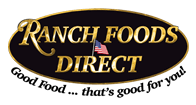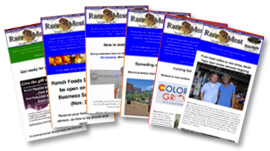Farm Show Magazine, November 22, 2016
When Kansas cattleman and feedlot owner Mike Callicrate couldn’t find a suitable buyer for his cattle due to a meat packer dispute, he found ways to sell them direct to the consumer. Now he does it all, from cow/calf herd to feedlot to meat market.
“We wanted an alternative path to market that delivered a high quality product,” says Callicrate.
The marketing effort starts with the ranch’s herd of Black Angus cows, some of which are bred to Wagyu bulls. The Wagyu is known for its very tender and highly marbled Kobe-style beef which sells at a premium.
When Callicrate started selling direct to consumers, he stopped using performance-enhancing drugs and growth hormone implants. In addition to his own calves, he feeds out calves from other breeders who follow his protocols.
“Cattle raised with hormones and steroids produce a tougher meat,” says Callicrate.
Callicrate started looking for a marketing alternative after joining 9 other cattlemen in the 1990’s suing a large packer for anti-competitive practices. He quickly found himself blackballed by the other major packers with no buyer for his beef.
He cut back his feeding operation from 12,000 to 1,000 head and started hauling fed cattle to a small slaughter plant in Colorado Springs, Colo. At the same time, he started Ranch Foods Direct to break down the carcass halves into cuts he could direct market.
On-Farm Slaughter

Mobile Slaughter Unit at Callicrate Cattle Co., St. Francis, KS
The mobile meat processor made setting up beef processing at his feedlot easy. The reefer contained everything needed and met all USDA regulations. It was also designed to be more humane and reduce stress on the animal.
“Hauling cattle long distances to packing plants and traditional slaughter systems stresses animals,” says Callicrate. “The stress hormones make for tougher meat. In our system, each animal is slaughtered separately and humanely with the least possible stress.”
Callicrate is now working with his 2nd generation meat-processing reefer. His current system, with its fully equipped trailer, corral, alleyway, kill-box and scale, cost $339,000.
“We started out planning a mobile unit, but you can set one up in a larger ag building like we did,” says Callicrate. “All you need is a docking station for water and disposal of waste.”
Callicrate likes the fact that the system employs local people working with locally produced livestock. He suggests readers interested in setting up a similar system check with Tri Van Truck Body in Washington State.
“They make a very nice unit for around the same cost,” he says.
With the new system, slaughter takes place outside in an enclosed area. The carcass is raised for bleeding, passes through a hide puller and into an evisceration area inside the reefer. A rotating processing rail makes handling the carcass easier as it goes through a carcass splitting area and a wash box before entering the carcass cooling area.
Callicrate extended the original reefer to add a carcass quartering section at the end of the cooler. It has a tight docking seal for additional cooling of carcass halves or for refrigerated transport.
“We can process up to 20 head per day,” says Callicrate. “With the second cooling reefer, we can process up to 50 head per day.”
No Waste Wasted
Hides are stored in a cooling and salting area until they can be shipped to a hide buyer. Slaughter wastes are added to a feedlot manure pile, where they compost naturally before being spread on area fields.
Wastewater is discharged into the farm’s ag lagoon after going through a constructed wetland.
When Callicrate first learned about bone char, he realized he had another product in the making. Instead of composting bones, he could add value to them.
“After we make soup stock from the bones, we make our own bone char,” says Callicrate. “We package it and sell it as a soil additive.”
The bones are processed in an Exeter Biochar Retort (Vol. 40, No. 5). The bone char contains 35 percent phosphorous and 33 percent calcium for a nutrient rich product. Callicrate also makes biochar from wood. Both are a haven for plant friendly bacteria when treated with compost tea or added to compost.
Callicrate sells the bone char and the biochar by themselves. He also mixes the biochar with composted wood chips and manure from the feedlot.
“We mix 5 percent biochar with the compost, and it goes into our Outdoor Garden Mix with Biochar,” says Callicrate. “It also goes into the Potting Soil Biochar Mix. We market everything through Ranch Foods Direct.”
Expanded Markets
Ranch Foods Direct has changed and grown, moving into larger buildings in Colorado Springs. The break plant cuts up Callicrate’s quarters as well as carcasses for other direct marketers. The retail operation sells half the beef slaughtered on the ranch and also markets produce and fruit from the region. The other 50 percent of the ranch’s beef is sold to restaurants from Pueblo to Boulder, Colo.
In addition to the restaurant and retail store sales, Callicrate has introduced Cowpool. It is a virtual store where family and friends, or even strangers, can go together to buy eighths, quarters, halves or whole carcasses.
A sample eighth carcass (62.5 lbs.) sells for $390.63. Depending on actual packaged weight, it would likely have 4 T-bones, 2 sirloin steaks, 4 rib eyes, 3 beef roasts and various other cuts including a beef shank, stew meat and soup bones, as well as 19 lbs. of ground beef.
Clubs and community organizations are encouraged to use Cowpool for fundraising. They can qualify for 5 percent of the sales they make.
Callicrate has also started raising hogs in outdoor huts, using unused feedlot space.
“We process them in the same trailer as the beef and smoke our own hams, shanks and bacon,” says Callicrate.
Contact: FARM SHOW Followup, Callicrate Cattle Co., 940 Road 12, St Francis, Kan. 67756 (ph 785 332-3344; info@CallicrateCattleCo.com; www.CallicrateCattleCo.com).

